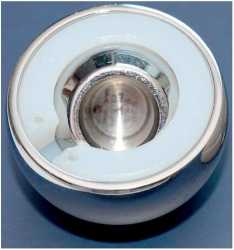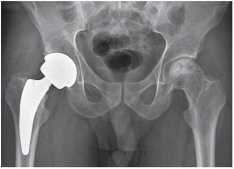869568934
220
Tomasz Poboży, Maciej Kielar

Figurę 6. Double-bearing, or “bali within a bali” bipolar prosthesis parę their home based on instructions given by their physical therapists on clearing walking paths and in-troducing any appliances for unobstructed walking during rehabilitation.
During the immediate post-operative period, pa-tients remain in bed with a triangular pillow placed between their legs. This abduction pillow is to prevent unrecommended movements, including rotation of the operated limb, which would be harmful in this period. On the second day, the patients undergo up-right mobilisation - first, they are helped up into a sit-ting position, then into a standing position, and they relearn how to walk with the help of a physical thera-

Figure 7. The Maxera™ acetabular system with Fitmore® hip stem and a large (44 mm) ceramic bali implanted in a 32-year-old man due to avascular necrosis of the femoral head
pist - first, with the use of a walking frame, then with elbow crutches. Most patients learn to use the walking aids well and walk longer and longer distances in subseąuent postoperative days. The gradual increase in weight bearing on the operated limb depends on factors such as the prosthesis fixation method. The use of cemented implant components allows for early weight bearing. Until recently, fuli weight bearing in the case of cementless anchoring, used to be discour-aged until 6-8 weeks after surgery. However, this period has shortened radically and the commonly estab-lished practice is becoming shorter to recommend fuli weight-bearing as soon as possible, in some cases even on the first or second postoperative day.
Walking exercises and practice in performing everyday activities on their own should be initiated at the hospital ward in which the patients under-went surgery. When the patients are able to walk far enough to reach the bathroom, while supervised, they may try sitting down on the toilet. Elevating the toilet seat by the use of a seat cover placed on top ensures maintaining a desired angle between the thigh and the trunk while sitting, to prevent inappropriate flex-ion and relative positioning of implant components [41-44]. Proper perioperative mobilisation has a sig-nificant effect on the rapidity of fuli physical recovery, considerably reduces the duration of hospital stay and post-operative convalescence, and minimises the risk of complications.
Conclusions
The type of prosthesis to be used in a particular patient depends mostly on the indications for surgery, the condition of the patienfs bones, the patienfs age and generał health status, the level of physical and social activity, and the presence of comorbidities and any other specific risk factors.
For example, a neck-sparing implant may be morę appropriate for a younger, morę active patient, while a long-stem implant may be morę appropriate for an older patient whose physical activity is limited by other factors.
Patients with inadequate bonę tissue structure (e.g. in osteoporosis) typically receive cemented pros-theses.
In the case of hip arthroplasty it is important to consider the materiał of the bearing surfaces, i.e. the internal surface of the acetabular cup and the surface of the bali (or head) of the implant.
Which hip joint prosthesis is the best? In light of the above, the answer seems obvious - the best prosthesis for one parson may not be the best prosthesis for someone else. For a young and active patient with good bonę structure the optimal solution seems to be a short-stem or neck-sparing prosthesis with a large ceramic head and an acetabular cup with a ceramic insert (Figurę 7).
Medical Studies/Studia Medyczne 2015; 31/3
Wyszukiwarka
Podobne podstrony:
216 Tomasz Poboży, Maciej Kielar Figurę 1. Spiron® prosthesis Figurę 2. MiniHip™ prosthe-sis The use
218 Tomasz Poboży, Maciej Kielar C Figurę 5. Acetabular cups: A - uncemented press-fit ace-tabular
222 Tomasz Poboży, Maciej Kielar 34. Mohaddes M, Rolfson O, Karrholm J. Short-term
214 Tomasz Poboży, Maciej Kielar hip arthroplasty should be considered in situations where pain does
uzupełniająca 2. Klocek Tomasz, Szczepanik Maciej. Siatkówka na lekcji
gear?ces Drill to match diameter of your bolt, or optionally for a bali bearing.
FIG 03(1) Figurę 4, A: a rake pick; B: a bali pick; C; a double bali pick; D: a diamond pkk. Figurę
więcej podobnych podstron